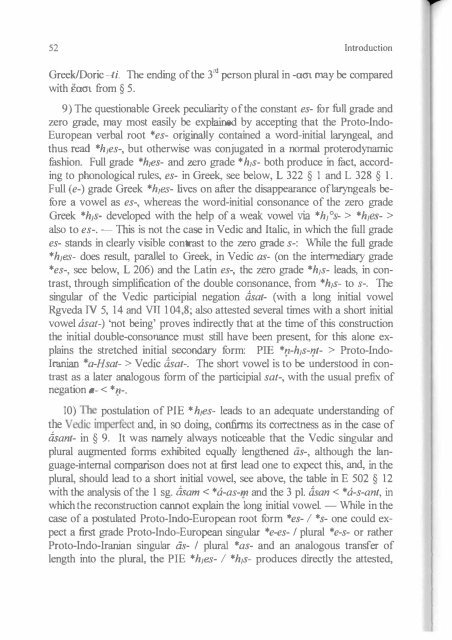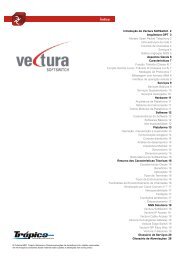Create successful ePaper yourself
Turn your PDF publications into a flip-book with our unique Google optimized e-Paper software.
52 IntroductionGreek/Doric -ti. 1be ending <strong>of</strong> the 3' " person plural in -am may be comparedwith eam from § 5.9) The questionable Greek peculiarity <strong>of</strong> the constant es- fo r full grade andzero grade, may most easily be explained by accepting that the Proto-IndoEuropean verbal root *es- originally contained a word-initial laryngeal, andthus read *h/es-, but otherwise was conjugated in a normal proterodynarnicfushion. Full grade *h/es- and zero grade * h,s- both produce in fuct, accordingto phonological rules, es- in Greek, see below, L 322 § I and L 328 § I.Full (e-) grade Greek *h/es- lives on after the disappearance <strong>of</strong>laryngeals before a vowel as es-, whereas the word-initial consonance <strong>of</strong> the zero gradeGreek *h/s- developed with the help <strong>of</strong> a weak vowel via *h/os_ > *h/es- >also to es-. - This is not the case in Vedic and Italic, in which the full gradees- stands in clearly visible contrast to the zero grade s-: While the full grade"h/es- does resuh, parallel to Greek, in Vedic as- (on the intermediary grade*es-, see below, L 206) and the Latin es-, the zero grade *h/s- leads, in contrast,through simplification <strong>of</strong> the double consonance, from "h/s- to So. Thesingular <strong>of</strong> the Vedic participial negation &sat- (with a long initial vowelRgveda IV 5, 14 and VII 104,8; also attested several times with a short initialvowel asal-) 'not being' proves indirectly that at the time <strong>of</strong> this constructionthe initial double-consonance must still have been present, for this alone explainsthe stretched initial secondary form: PIE *IJ-h/s-nt- > Proto-Indo-•.. .LIranian * a-Hsal- > Vedic asat-. The short vowel is to be understood in contrastas a later analogous form <strong>of</strong> the participial sal-, with the usual prefix <strong>of</strong>negation 0- < * Q-.10) The postulation <strong>of</strong> PIE * h/es- leads to an adequate understanding <strong>of</strong>te Vedic unperfect and, in SO doing, confirms its correctness as in the case <strong>of</strong>iisant- in § 9. It was namely always noticeable that the Vedic singular andplural augmented forms exhibited equally lengthened as-, although the language-internalcomparison does not at first lead one to expect this, and, in theplural, should lead to a short initial vowel, see above, the table in E 502 § 12with the analysis <strong>of</strong> the I sg. &sam < *a-aS-Tf! and the 3 pI. &san < *a-s-ant, inwhich the reconstruction cannot explain the long initial vowel. - While in thecase <strong>of</strong> a postulated Proto-Indo-European root form "es- / *s- one could expecta first grade Proto-lndo-European singular *e-es- / plural *e-s- or ratherProto-lndo-Iranian singular iis- / plural *as- and an analogous transfer <strong>of</strong>length into the plural, the PIE *h/es- / *h/s- produces directly the attested,The Reconstruction <strong>of</strong> Proto-lndo-European 53unified paradigm: PIE *e-h/es- > Proto-Indo-Iranian *il-Has-' > *a.as- > iisandthe plural *e-h/s- > Proto-lndo-Iranian *a-Hs- > iis-.11) Contrary to today's research and its laryngeal *h,es-, earlier research,with its postulation <strong>of</strong> the simple non-larygeal *es- /*s-, had considerable argumentativedifficulties. As representative <strong>of</strong> the communis opinio <strong>of</strong> thetime, one may cite Thumb / Hauschild Handbuch des Sanskrit I / 2 1959 § 488(as well as Leurnann LLFL 1977 p. 522 § 400.A.lb). Thumb and Hauschilddraw a direct parallel between the Vedic sanli and the Doric Greek Ev"ti. andtrace it via "henti back to "senti. Through analogy to the singular, the expectedaspiration is eliminated. Correspondingly, 10niclAttic Greekelai would be traced back to *hensi or rather *sensi (with Southern Greek -siinstead <strong>of</strong> -11). But in the case <strong>of</strong> the I" person plural "smen and the 2" " personplural "sle the initial e- would be analogously introduced. But the extension <strong>of</strong>the analogous e- to the stems <strong>of</strong> the optative and the participle cannot be explained.Further, the Mycenaean -e-o-Ie, i.e. -ehontes, known since 1952,fo rces the pushing forward <strong>of</strong> the analogy in question into the 2nd milleniumBC. 1be communis opinio leaves one utterly helpless before the Mycenaeane- <strong>of</strong> the 3 pI. e-e-si, i.e. ehensi, particulatly if one, in the cases <strong>of</strong> Ionicl Atticelai and Doric Ev"ti., believed he could succeed with the use <strong>of</strong> *senti.But despite all evidence: Even today there are researchers who happilycontinue to use *es- / *s- as a starting point and build hypotheses fromthere: -+ K. Shields "On the Origin oJ Dialeclal Ablaut Patterns oJ IhePresenl Aclive Indicative oJPIE "es To Be"' in HS 110 1997 p. 176-180.E 505. As a result <strong>of</strong> the first three steps <strong>of</strong> E 502-504, both <strong>of</strong> the followingparadigms may with certainty be attributed to Proto-IndoEuropean:Proto-lndo-European*h1es- 'to exist'*hJes-mi*h/esi < " hIes-si*h/es-ti*h1s-me*h/s-Ie"h/s-entiProto-lndo-European*hJej- 'to go'*h1ej-mi*h/ej-si*h/ej-ti*h/i-me*h/i-Ie*h/j-enti3 Nota bene: Because the laryngeal quality <strong>of</strong> Indo-Iranian laryngeals is no longerrecognizeable, J note it nonnally with H.





